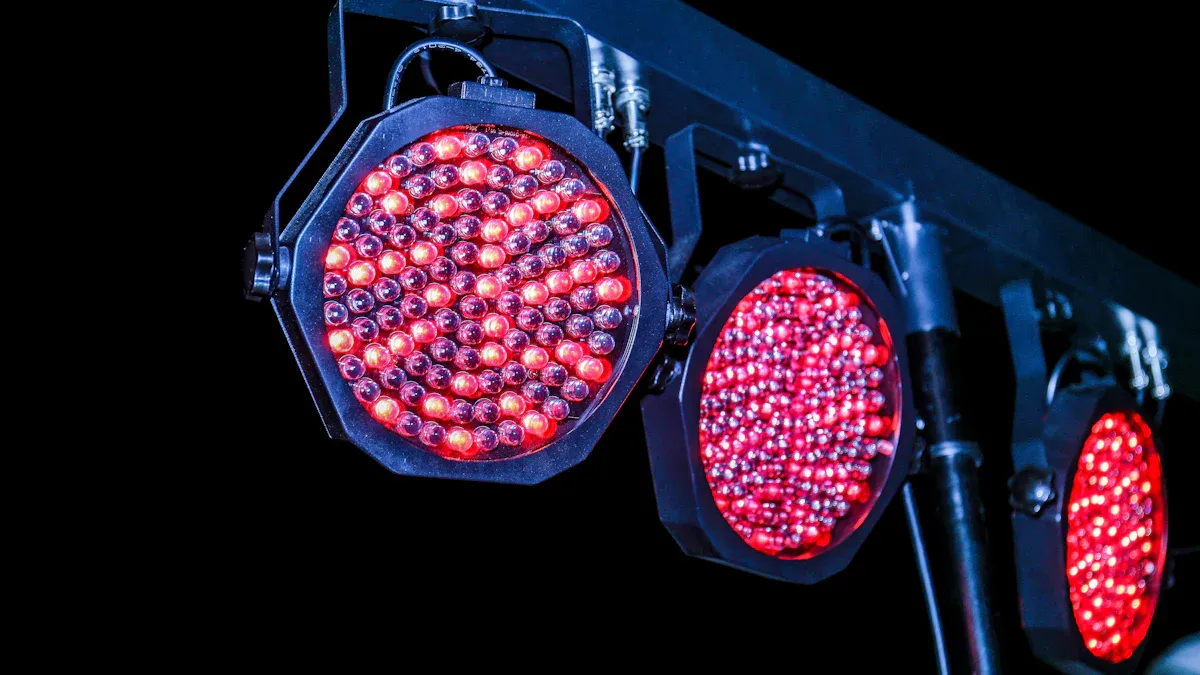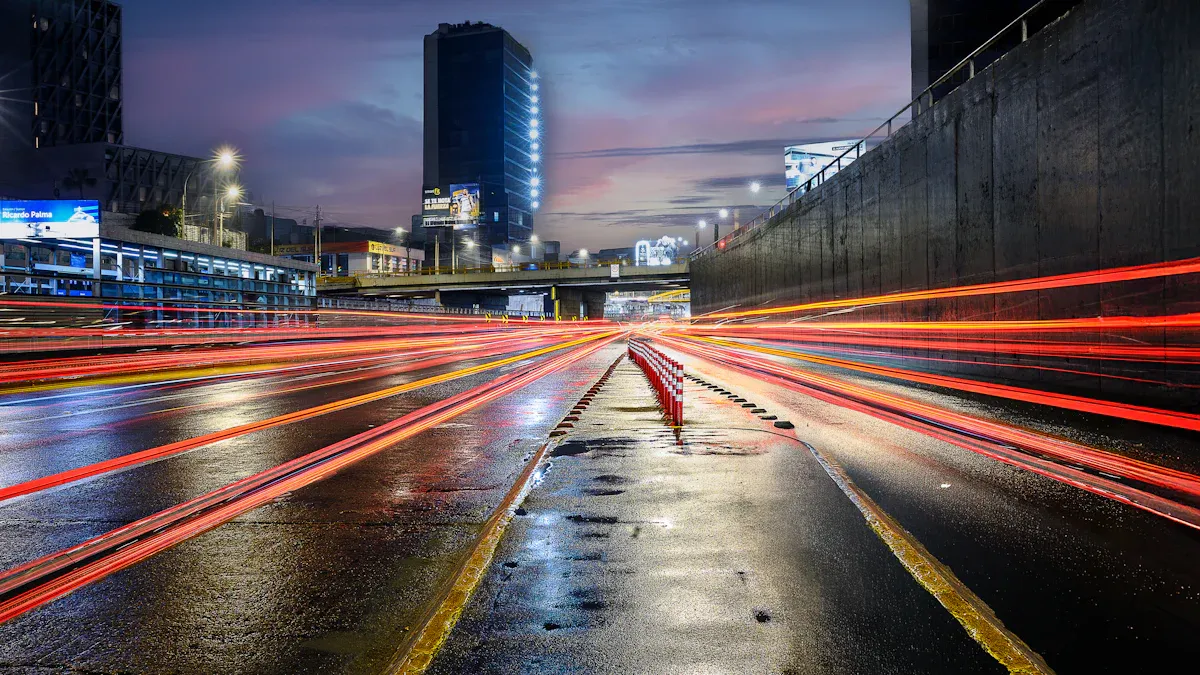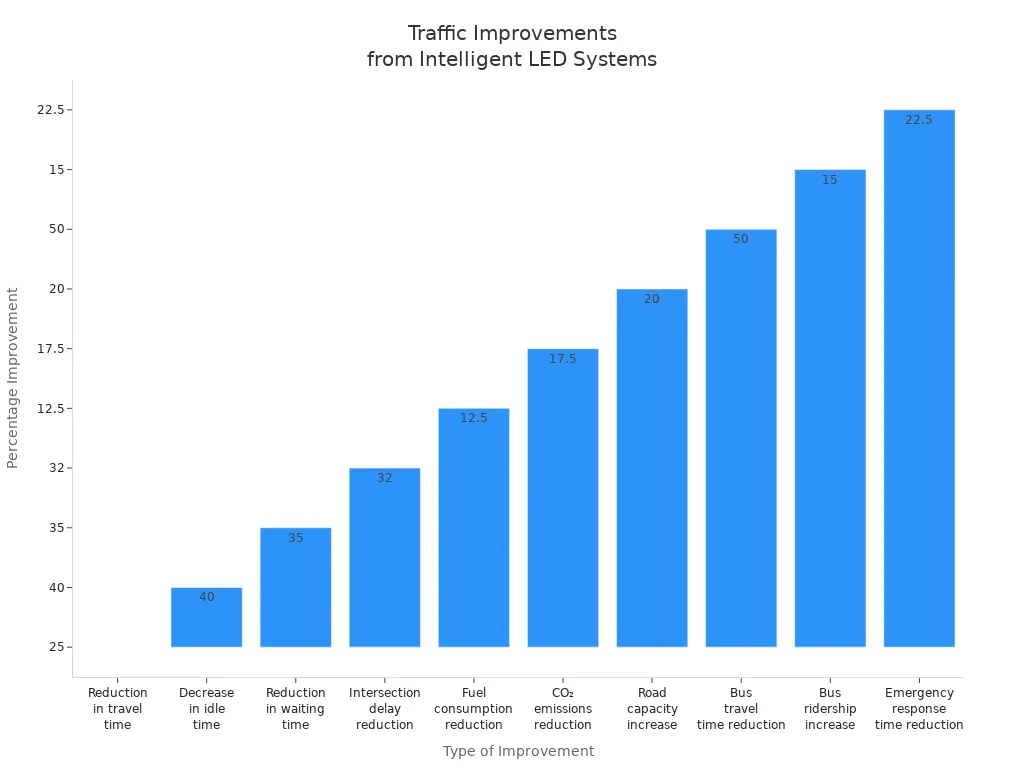LED Traffic Lights and How They're Revolutionizing Road Safety and Energy Efficiency

You see LED traffic lights in many places today, from busy streets to residential areas near your home. These new LED lights help keep roads safe while allowing cities to use less energy. If you visit the About Us section of many city websites, you'll find information about their commitment to upgrading to smart LED street lights. These products can adjust their brightness and send real-time updates to improve traffic management. Studies show that special LED warning lights at crosswalks increase driver compliance, with over 63% of drivers stopping for these lights compared to only 19% for old lights. Many cities choose LED traffic lights for better visibility and lower costs, making them a popular product in urban planning and safety initiatives.
Key Takeaways
LED traffic lights are brighter than old bulbs. They also last much longer. This helps make roads safer. It also means less fixing is needed.
These lights use up to 80% less energy. This helps cities save money. It also cuts down on pollution. This makes the air cleaner.
Smart LED systems can change brightness and timing right away. This helps traffic move better. It also helps emergency vehicles get there faster.
LED traffic lights work well in any weather. They can stay on during power outages with backup power.
Cities that use LED traffic lights and smart controls have fewer traffic jams. They also have less pollution. Streets are safer for everyone.
LED Traffic Lights

Enhanced Visibility
When you get close to an intersection, you need to see the signal well. LED traffic lights use new technology to make signals brighter and easier to notice. Research shows LED signals help people react faster, so there are fewer accidents. The light from LEDs is more focused than old bulbs. This means you can see the signal in fog, rain, or bright sun. Different shapes and angles help you see the signal from many places. LED modules use special glass to make the light even brighter and clearer. This gives you better visibility and safer roads.
Tip: LED traffic lights use about 80% of their energy to make visible light. Old bulbs waste most of their energy as heat.
Durability and Lifespan
You might see that LED traffic lights do not break often. LEDs last much longer than old bulbs. Most LED signals work for 50,000 to 100,000 hours. This means they can last over ten years. Old bulbs only last about 1,000 hours, so cities must change them a lot. With LEDs, workers spend less time fixing signals. This saves money and causes fewer traffic problems. For example, Phoenix changed many signals to LEDs and saved a lot of money each year. LEDs also work better in bad weather, so you see fewer outages in winter or storms.
Traditional Traffic Lights | LED Traffic Lights | |
|---|---|---|
Lifespan | ~1,000 hours | Up to 100,000 hours |
Maintenance Frequency | High | Low |
Durability in Harsh Weather | Lower | Higher |
Real-Time Updates
LED traffic lights can be watched and controlled from far away. This helps cities manage traffic better. With real-time remote monitoring, you get quick updates about crashes, lane blocks, or bad weather. LED signals can turn to flashing red if the power goes out. Backup batteries and solar panels keep signals working when the main power stops. Real-time remote monitoring lets workers change signals fast to help traffic move and help emergency teams. These smart features make LED traffic lights important for today’s cities.
LED traffic lights use real-time remote monitoring to:
Find power failures and switch to backup power.
Give quick updates for traffic flow.
Help emergency teams get there faster.
Improving Safety

Brighter Signals
When you drive through an intersection, LED signals look different. They are much brighter and the colors are easy to see. Red, yellow, and green stand out more than old bulbs. This helps you react quickly and follow the rules. Drivers can see these signals from far away, even in fog or rain. Studies show bright lights help drivers react faster and feel less stressed. When you see a bright signal, you know what to do. This means fewer mistakes and safer roads for everyone.
Note: Bright LED signals help drivers and people walking see traffic instructions. This makes things less confusing and helps stop accidents.
Reliability in Weather
LED traffic lights work well in all kinds of weather. You can see the signals in heavy rain, snow, or fog. The LED beam stays strong, so you do not miss the signal. Heat-resistant parts keep the lights working in hot or cold weather. Cities use strong poles and designs that stand up to wind during storms. Flexible joints help the lights bend instead of break. Cleaning and anti-icing coatings keep the lenses clear. You get signals you can trust, even when the weather is bad.
Special optics let you see signals from many angles.
Anti-icing coatings and cleaning keep signals easy to see.
Strong designs protect signals during storms.
Smart LED Street Lighting
Smart LED street lighting helps make city roads safer. These systems use sensors and controls to change brightness when needed. Lights get brighter at night or when more people are around. In New Zealand, smart street lights helped lower deadly crashes by half. Smart LED street lighting does more than shine bright. It uses blue lights and changes brightness at intersections to warn drivers. These features help you notice changes and stay alert.
Smart LED street lighting also works with emergency vehicle systems. When an ambulance or fire truck comes, the lights and signals change to clear the way. The system uses GPS and cloud software to talk to signals and streetlights. You see flashing lights that warn you about emergency vehicles or work zones. This helps emergency teams get there faster and lowers crashes at intersections by up to 70%. Smart LED street lighting helps keep drivers, walkers, and emergency workers safe.
Feature | Benefit for Safety |
|---|---|
Adaptive brightness | Better visibility at night |
Blue lights at intersections | Extra warning for drivers |
Emergency preemption | Faster response, fewer crashes |
Smart sensors | Adjusts to traffic flow |
Tip: Smart LED street lighting does more than make roads bright. It uses new technology to keep people safe and help cities handle emergencies fast.
Making roads safer takes more than just bright lights. Smart LED street lighting, strong LED signals, and smart systems work together to protect you and others.
Energy Efficiency
Lower Power Use
LED traffic lights use much less power than old bulbs. An incandescent light uses about 100 watts. An LED light only needs 15 to 20 watts. You still get a bright signal with less energy. Cities save up to 80% or even 90% on energy. Using LEDs helps lower electricity bills for your city. LEDs are very efficient, so less power is wasted. More light goes where it is needed.
Did you know? LED traffic lights need only a small amount of energy. This big drop in energy use helps city budgets and the environment.
Reduced Emissions
Using less energy helps the planet. LED traffic lights lower the need for electricity. Power plants burn less fuel when cities use LEDs. This means fewer greenhouse gases in the air. Smart LED systems can change brightness and timing for traffic. These features help cut down car idling and stop-and-go driving. Less pollution is made when you stop at an LED signal.
Aspect | Explanation |
|---|---|
LED traffic lights use much less electricity, reducing city energy demand by up to 70%. | |
Carbon Emissions | Lower energy use means less fossil fuel burned, so cities see a drop in greenhouse gases. |
Adaptive Lighting | Sensors and timers let LEDs shine only when needed, saving energy without losing safety. |
Smart Integration | LEDs work with smart traffic systems to keep cars moving, which lowers emissions from idling. |
Extended Lifespan | LEDs last longer, so cities use fewer resources and create less waste. |
The U.S. EPA says LED street lights could save enough energy to power 1.5 million homes each year. Supporting LED traffic lights helps make your city cleaner and greener.
Cost Savings
LED traffic lights help cities save money in many ways. Energy bills go down right away. New York saved $14 million in two years after switching to LEDs. The U.S. Department of Energy found LEDs cut streetlight energy use by half. LEDs last much longer than old bulbs. Workers do not need to replace them as often. This means less money spent on repairs and fewer traffic delays.
Municipality / Source | Cost Savings / Energy Reduction / Benefits |
|---|---|
New York City (2015-2017) | $14 million saved in maintenance and energy costs after replacing 250,000+ street lights with LEDs |
U.S. Department of Energy | LED retrofits reduce energy use by 50%, streetlights can be up to 40% of city electricity bill |
LED Lifespan | LEDs last 2 to 5 times longer than traditional lighting, reducing maintenance costs |
Smart LED Controls (Greenville, SC) | Smart controls can lower energy consumption by up to 80% while enhancing safety |
Siemens engineers made LED traffic lights even better. Their Sitraffic One LED technology uses special digital driver modules. These lights run on just 1-2 watts. Old bulbs needed 60 watts. Siemens added smart sensors and better heat control. The lights last longer and need less care. Cities get reliable signals, lower costs, and better energy efficiency.
Tip: When your city uses LED traffic lights, you help save money, cut pollution, and support a greener future.
Enhancing Traffic Flow
Intelligent Systems
Smart traffic lights with sensors and AI help you travel easier. These systems watch traffic as it happens and change signals to fit the flow. Sensors like inductive loops, infrared, and video help teams see where cars, buses, and bikes go. AI uses old and new data to change signal times. This means you wait less at red lights. You see fewer traffic jams and less stopping and starting.
Cities such as Singapore, San Francisco, and Copenhagen use these systems. Singapore uses sensors and special road pricing to keep cars moving, even with many people. San Francisco’s Connected Corridor lets buses, walkers, and emergency vehicles go first. Copenhagen’s system helps bikes and walkers cross safely. This cuts stops for bikes by 10%. Pittsburgh’s Surtrac AI system made travel time 25% shorter and wait times 40% less. London’s SCOOT system finds cars with 98% accuracy. This makes traffic management work better.
Tip: Smart traffic lights can cut emissions by up to 21%. They also save fuel and help keep your city clean.

Measurable Improvement | Percentage / Value | City / Example |
|---|---|---|
Reduction in travel time | Up to 25% | Pittsburgh (Surtrac) |
Decrease in idle time at intersections | 40% | Pittsburgh (Surtrac) |
Overall intersection delay reduction | 32% | Los Angeles (ATSAC) |
Fuel consumption reduction | 10-15% | Various cities |
CO₂ emissions reduction | 15-20% | Various cities |
Road capacity utilization increase | 20% | AI-enabled optimization |
Bus travel time reduction | Over 50% | San Jose |
Bus ridership increase | 15% | San Jose |
Emergency vehicle response time reduction | 20-25% | General AI traffic lights |
Urban Mobility
LED traffic lights connect to urban mobility platforms to help you move around. These systems use IoT and AI to talk to buses and trains. This gives them green lights and cuts delays. Teams use real-time data to change signals. This keeps public transit on time. Cities like Stockholm and Amsterdam show how smart systems help people get to work faster. You wait less and your ride is smoother.
Smart traffic management helps you switch between ways of traveling. Ultrasonic sensors in traffic lights help you cross streets quickly and safely. These sensors change crossing times for walkers and bikes. This makes moving around the city easier. Cities like New York, Tokyo, and Singapore use these systems to cut traffic and pollution. You see fewer crashes and breathe cleaner air.
Flexible systems let cities add new features when needed. You get better traffic flow, safer roads, and better public transit. Teams learn from each upgrade and keep making your city better.
You can see LED traffic lights making city traffic better. These lights are brighter, save money, and help the planet. The table below shows how drivers, cities, and nature all get something good from LED traffic lights:
Beneficiary | Key Benefits | Description |
|---|---|---|
Drivers | Safety, reliability | Brighter signals and fewer disruptions |
Cities | Cost savings, improved traffic management | Lower energy use and better flow |
Environment | Sustainability | Less waste and fewer emissions |
Smart traffic systems use LED lights, sensors, and AI to keep roads safe. These systems help cars move smoothly and make travel easier. When more cities use these smart systems, the air gets cleaner. You will also see less traffic and safer streets. The future is bright for cities that use smart traffic solutions.
FAQ
What makes LED traffic lights better for energy efficiency?
LED traffic lights use less electricity than old bulbs. Cities save money on energy bills. These lights help the environment by using less power. LED technology turns more energy into visible light. This makes them more efficient and helps cities manage traffic in a greener way.
How do LED traffic lights help with improving safety?
LED traffic lights shine brighter at intersections. The colors are clear and easy to see. This helps you react quickly and make fewer mistakes. Smart LED street lighting and real-time monitoring also make roads safer. They help cities manage traffic better.
Can LED traffic lights work during power outages?
LED traffic lights can stay on when the power goes out. Backup batteries and solar panels keep them working. Teams can use real-time monitoring to switch signals to flashing red. This helps keep people safe and traffic moving during outages.
How do smart LED street lighting systems enhance traffic flow?
Smart LED street lighting uses sensors and AI to change signal times. These systems help buses, bikes, and cars move faster. Cities use these lights to cut down on delays. Flexible deployment lets cities adjust lights for better traffic flow.
Are portable traffic signal lights useful for temporary deployment?
Portable traffic signal lights are good for roadwork or events. They are easy to set up and move. These signals help keep traffic moving during changes. Cities use them to keep roads safe and traffic running smoothly.

